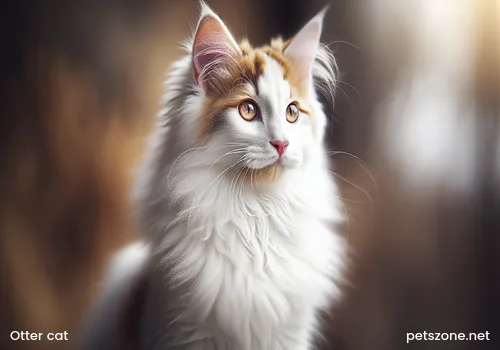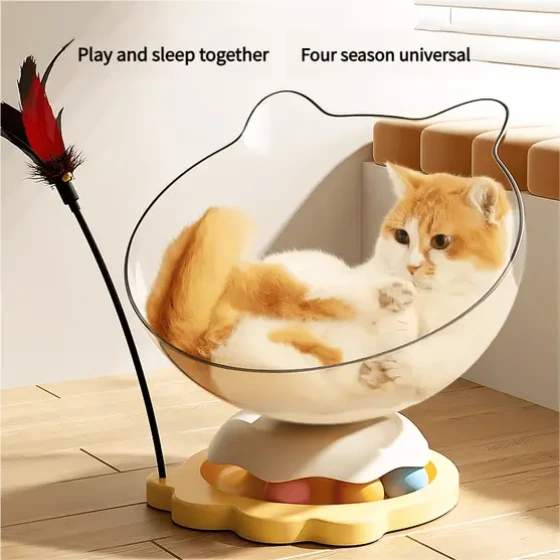Do Otter Cats Swim_Exploring the Unique Habits of Swimming Cats
“Otter cat” usually refers to a type of cat that likes playing with water like an otter and can even swim. Although rare among felines, these cats do exist, breaking the common perception that cats generally fear water.

Although most cats give the impression of avoiding water and treating baths like a “world war,” this is mainly because their ancestors lived mostly in arid regions, lacking exposure and adaptation to water. However, felines inherently have the instinct to swim. Some specific cat breeds, due to their genetic background, living environment, or unique personalities, have a higher tolerance for water and even show a love for swimming. These cats can be figuratively called “otter cats.”
Why do most cats generally dislike water?
Before diving into “otter cats,” let’s first understand why most cats dislike water. The main reasons are:
- Ancestors' living environment: Domestic cats descended from wildcats in the Middle East, living in arid or sparse grassland areas with little contact with water, so they did not evolve habits adapted to aquatic environments.
- Fur characteristics: Most cats' fur lacks good water resistance. Once wet, their fur becomes heavy and takes a long time to dry, making cats feel very uncomfortable and cold, similar to how we feel wearing wet clothes.
- Sensitivity to scent: Cats mark their “territory” through scent on their bodies. Bathing washes away these scents, causing anxiety. Furthermore, the smell of shampoo can be too strong and complex for cats with sensitive olfactory senses, making them dislike it.
- Loss of control: Cats are accustomed to moving on solid ground; unstable and uncontrollable environments like water may cause fear.
- Unpleasant experiences: If cats have had bad water-related experiences such as near-drowning or forced baths causing fright, psychological shadows may form, increasing their aversion to water.
- Ear structure: Cats’ ears are easily penetrated by water, and their ear canal structure makes it difficult to expel water, causing discomfort and increasing the risk of ear diseases.
Revealing breeds of cats that swim
Although most cats avoid water, some “exceptions” are naturally fond of water and even good swimmers. These unique cat breeds, called “otter cats,” include:
- Turkish Van: One of the most famous “swimming cat” breeds. They originate from the Van Lake area in eastern Turkey. The hot summers there may have encouraged them to learn swimming to cool off. Turkish Van cats have uniquely water-resistant coats that dry easily after getting wet. They are smart, lively, love playing in water, and have even been observed fishing in lakes.
- Maine Coon: Known for their large size, Maine Coons are beloved for their gentle, friendly, and dog-like personalities. Some Maine Coons show interest in water, playing with water bowls or frolicking by water. Their thick, water-resistant fur helps them adapt to cold, damp environments.
- Bengal Cat: A hybrid of Asian leopard cats and domestic cats. Their wild ancestors’ genes may give them a love for water. Bengals are usually very active, curious, and intelligent, liking to play with water and even join their owners in bathtubs or pools.
- Siberian Forest Cat: Originating from Russia, this breed has dense, water-resistant fur adapted to cold climates. Some Siberians enjoy water play and may even try fishing in water.
- Turkish Angora: Also from Turkey, Turkish Angoras enjoy playing with water. They may splash around in sinks, water bowls, or under running faucets.
- Abyssinian: An ancient, energetic, and curious breed. Some Abyssinians like to play in water bowls or show interest in water flowing from faucets.
- Japanese Bobtail: Originating from Japanese islands, these cats may also show a fondness for water.
- Manx: From the Isle of Man in the Irish Sea, Manx cats living near water may also enjoy it.
It is important to note that even among these breeds considered water-loving, individual differences exist. Not every Turkish Van is necessarily a swimming expert, nor does every Bengal have a strong affection for water. Like humans, each cat has its own personality and preferences.
What is an "otter"?
Since we mentioned “otter cats,” let’s briefly learn about real otters. Otters are semi-aquatic mammals belonging to the weasel family. They are born swimmers and divers, with streamlined bodies, short rounded limbs, and long thick tails—all physical traits perfect for water activity. Otters have dense, somewhat water-resistant fur that helps maintain body temperature. They mainly feed on fish and also catch frogs, shrimp, and other aquatic animals. Interestingly, a wild feline called the “Jaguarundi” in Mexico is sometimes figuratively called the “otter cat” because of their slender body, flat head, small rounded ears resembling otters. They are also excellent swimmers and fish hunters.
How to interact with cats that like water?
If you happen to have a cat interested in water, try these ways to interact:
- Provide opportunities to play with water: Prepare a shallow water basin with floating toys for the cat to play in. Keep the water shallow to ensure safety.
- Try dripping faucets: Some cats like playing with running water from faucets; let them play safely for a while.
- Gradual exposure: To help cats get more accustomed to water, start with shallow water and slowly increase depth, letting them adapt step by step.
- Positive encouragement: Give rewards and encouragement while the cat plays with water to associate water play with pleasant experiences.
Important reminder: Never force cats into the water, which could cause fear and stress. Always ensure the cat’s safety in water, especially outdoors, and supervise to prevent accidents.
Common FAQs
- Can all cats swim?
Theoretically, all cats have the instinct to swim, like their big cat relatives such as tigers and jaguars. But not all domestic cats are good or willing swimmers. Whether they swim well depends largely on individual differences, upbringing, and water exposure. - Why are some cats not afraid of water?
Some cats are not afraid of water possibly due to genetic factors from breeds originating near water bodies. Also, early positive experiences with water and good water-related awareness can make cats more accepting of water. - What should be noted when bathing cats?
Avoid frequent bathing to protect their natural skin oils. Use cat-specific bathing products, keep water temperature suitable, and dry them promptly with towels and a hairdryer to avoid catching a cold. - Is "otter cat" an official breed?
“Otter cat” is not a formally registered breed name. It is an informal term describing cats that like water and swim like otters. Some breeds like Turkish Van are informally called “swimming cats” due to their affinity for water.
In summary, although most cats avoid water when possible, some water-loving “otter cats” truly exist, breaking stereotypes and showcasing the diverse charm of the feline family.



